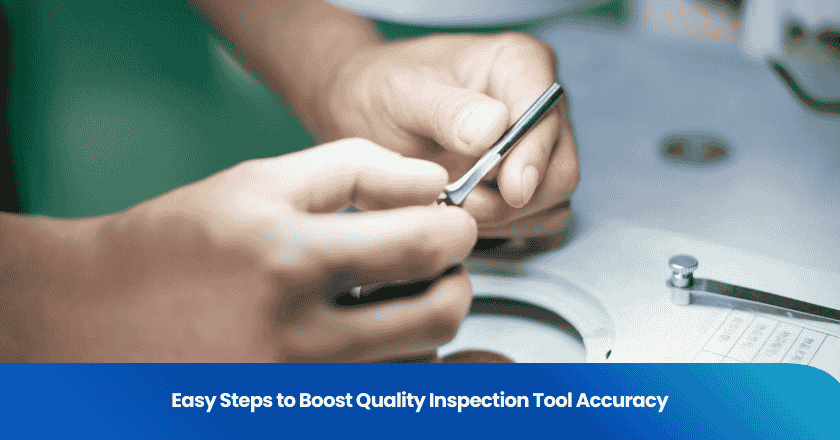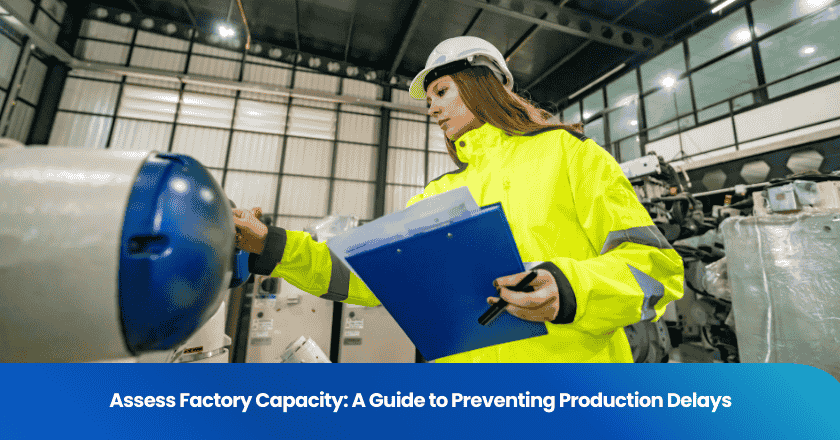
Improving the accuracy of quality inspection tools requires just a few practical steps. When you understand tool specifications and follow best practices, you reduce error rates and boost defect detection.
- AI systems inspect thousands of parts per minute, minimizing defects and predicting issues before they occur.
- Manual inspections often result in higher error rates and unreliable reports after extended periods.
| Cost Implication | Description |
|---|---|
| Financial losses | Manufacturers lose an estimated $1.3 trillion annually due to quality failures. |
| Increased labor costs | Manual inspections increase labor costs significantly. |
| Costly recalls and compliance failures | Inaccurate tools can lead to recalls and penalties, risking business stability. |
Both new and experienced professionals can benefit from making these improvements right away for more reliable inspection outcomes.
Key Takeaways
- Understand your inspection tools. Each type serves a specific purpose in the production process. Choose the right tool for the job to enhance accuracy.
- Regularly calibrate your inspection tools. Calibration ensures accuracy and compliance with industry standards, preventing costly errors and recalls.
- Implement strategic inspections at critical points. Catch defects early to improve product quality and reduce waste in your production process.
- Use structured checklists for inspections. Checklists standardize procedures, minimize errors, and ensure thoroughness in quality control.
- Invest in user training for your team. Proper training enhances tool usage, reduces mistakes, and fosters a culture of continuous improvement.
Tool Specifications
Know Your Inspection Tools
You need to understand the types of quality inspection tools available in industrial settings. Each tool serves a specific purpose and fits different stages of production. Here are the most common types:
1. Pre-Shipment Inspection: Verifies quality before shipping, conducted when goods are fully produced and mostly packaged.
2. During Production Inspection (DUPRO): Takes place while production is ongoing, usually when a portion of goods is completed.
3. Pre-Production Inspection (PPI): Checks raw materials and factory readiness before production begins.
4. Loading Inspection: Ensures products are loaded safely and correctly for shipment.
5. Sort Inspection: Examines batches of finished products to identify and remove defective items.
You should review the specifications of each tool before use. Consider the following key factors when selecting quality inspection tools for your operation:
| Key Specification | Description |
|---|---|
| Assess Product Risk Level | Evaluate risks based on product complexity, end-use, and safety hazards. |
| Understand Industry Standards | Familiarize yourself with standards like ISO 9001, ISO 2859, and industry-specific guidelines. |
| Match Inspection Type to Business Needs | Align inspection efforts with your operational model and product lifecycle. |
| Choose the Right Inspection Method | Select methods based on product characteristics, such as visual inspection or dimensional measurement. |
| Consider Internal Resources and Capabilities | Assess your team's expertise, available tools, and inspection capacity. |
| Evaluate Inspection Service Providers | Choose providers with strong accreditation, experience, and transparent reporting. |
Automated machine vision systems offer a faster, more accurate, and highly consistent solution compared to manual inspection methods. These systems quickly determine whether a product meets quality standards by analyzing visual data against predefined criteria.
Match Tools to Tasks
You improve measurement accuracy when you match inspection tools to specific tasks. Each tool type has strengths and limitations. Select the right tool for the job to ensure reliable results.
| Tool Type | Description |
|---|---|
| Precision Hand Tools | Quick measurements; portable but less precise. |
| Contact Sensor Systems | Accurate readings for rigid materials; physical contact required. |
| Calipers and Micrometers | Calipers measure various dimensions quickly; micrometers excel at small, precise measurements. |
| Coordinate Measuring Machines | Capture 3D measurements with high precision; ideal for complex shapes. |
| Noncontact Optical Sensor Systems | Use light for delicate materials; enable fast, noninvasive inspection. |
| Optical Comparators | Project magnified silhouettes for visual assessment of dimensional accuracy. |
| Vision Systems | Cameras provide detailed images; enable high-speed, high-accuracy measurements. |
| Laser and Structured-light Scanners | Capture detailed 3D models; widely used for intricate inspections. |
You gain several advantages by using automated quality inspection tools. These include consistent defect detection, high-speed inspection for large-scale production, and reduced labor costs. AI-powered systems analyze thousands of images, detect patterns, and identify anomalies that manual methods might miss. This approach suits high-volume production environments where precision and speed matter most.
Calibration and Maintenance
Regular Calibration
You maintain inspection tool accuracy by scheduling regular calibration. Calibration frequency depends on several factors, including how often you use the equipment, the environment, and the type of tool. Industry standards such as ISO 9001 require you to keep a calibration register, but do not specify exact intervals. Experts recommend calibrating tools every three to six months, especially in high-volume production environments.
- Calibration frequency varies by tool type and usage rate.
- Environmental conditions, such as temperature and humidity, affect calibration needs.
- ISO 9001 requires a calibration register for compliance.
- High-volume operations benefit from more frequent calibration.
Regular calibration ensures your equipment performs according to specifications. Accurate devices improve efficiency, allowing you to make faster decisions and avoid delays. In manufacturing, uncalibrated tools can lead to rejected batches and costly recalls. In clinical settings, inaccurate devices may cause misdiagnosis or inappropriate treatment. Calibration also demonstrates compliance with safety standards, helping you avoid fines and loss of certification.
Tip: Keep detailed calibration records to show compliance with international standards and support audits.
| Standard | Description |
|---|---|
| ISO 9901 Part 4.11 | Requires identification, calibration, and adjustment of inspection equipment at set intervals. |
| ISO 9001 Section 7.1.5.2 | Mandates calibration against standards traceable to international or national benchmarks. |
| NIST Calibration Standards | Provide measurement accuracy and consistency across industries. |
Preventive Maintenance
You extend the lifespan of inspection tools by following preventive maintenance practices. Regular inspection, cleaning, and lubrication help you identify issues early and maintain precision.
- Conduct visual inspections to detect wear, cracks, or damage.
- Clean and lubricate moving parts to reduce friction and prevent breakdowns.
- Sharpen cutting edges to maintain measurement quality.
- Use structured checklists for consistent maintenance routines.
Routine maintenance reduces downtime and ensures your tools deliver reliable results. By addressing minor problems before they escalate, you protect your investment and maintain high standards in your inspection process.
Quality Control Checks
Strategic Inspections
You improve defect detection rates by placing quality control checks at critical points in your process. Strategic inspections help you catch issues early and prevent defective products from reaching customers. Machine vision systems can inspect hundreds of products per minute, maintaining consistent quality even as production speeds increase. These systems identify a wide range of defects, such as contamination or dimensional errors, which boosts your ability to detect problems quickly. Real-time feedback from these inspections allows you to make immediate adjustments, reducing waste and improving overall product quality.
To reduce inspection errors, you should use a variety of quality control check methods:
- Visual inspection: Check for visible defects like scratches or incorrect labels.
- Measurement inspection: Use tools to confirm products meet size and weight standards.
- Functional testing: Test products to ensure they operate as intended.
- Destructive testing: Push products to their limits to verify safety and durability.
- Statistical process control: Monitor production quality in real time using data.
- Six Sigma: Focus on eliminating defects and reducing variation.
- Total quality management: Apply a company-wide approach to continuous improvement.
- 100% inspection method: Examine every product, which works best for high-value items.
Tip: Place inspections at points where defects are most likely to occur, such as after assembly or before packaging, to maximize effectiveness.
Use Checklists
You ensure consistency and accuracy in your inspections by using structured checklists. These tools standardize your process, making it easier to follow each step and avoid missing critical tasks. In industries like construction, checklists reduce errors and help maintain high-quality outcomes by breaking down inspections into clear, actionable items. Digital checklists further improve thoroughness and consistency, helping your team meet regulatory standards and manage assets more effectively.
Checklists also serve as standard operating procedures. They simplify training for new team members and create repeatable workflows. By providing step-by-step instructions, checklists minimize human error and help you track progress. This structured approach is essential for maintaining uniformity and ensuring that your quality control checks deliver reliable results every time.
Documentation and Procedures
Standardize Records
You improve quality control inspections by keeping your records standardized and up to date. Standardized records help you track trends, identify recurring issues, and support compliance with industry regulations. When you use a centralized hub for your quality processes, you avoid errors and make it easier to access important data. Structured processes and tailored checklists ensure that every inspection plan follows the same steps, which leads to more reliable results.
Here are best practices for standardizing your inspection records:
| Best Practice | Description |
|---|---|
| Develop an inspection plan | Define quality standards, sampling methods, and reporting procedures for effective inspections. |
| Train inspectors | Update training programs to include the latest standards and technologies. |
| Utilize advanced technologies | Use automation and statistical sampling to improve reliability and efficiency. |
| Conduct regular audits | Perform internal audits to spot non-compliance and improve inspection processes. |
| Create tailored checklists | Build checklists specific to your inspection plan for consistency and efficiency. |
You should also follow documentation standards set by regulated industries. For example, ISO 26262 and IEC 61508 require you to document every step of your inspection plan. These standards help you maintain safety and quality in your operations.
Clear Inspection Procedures
Clear and current inspection procedures form the backbone of successful quality control inspections. When you update your inspection plan regularly, you ensure that your team follows the latest safety and compliance requirements. Well-documented procedures help you identify hazards, improve safety performance, and provide essential data for audits. In fact, effective safety systems have led to a significant drop in workplace fatalities over the past decades.
To create strong inspection procedures, you should:
- Write step-by-step instructions for each inspection plan.
- Use checklists for final product inspections.
- Schedule regular reviews and updates of your procedures.
- Set up audit processes to verify compliance and spot areas for improvement.
By following these steps, you make your quality control inspections more consistent and reliable. You also create a culture of accountability and continuous improvement in your organization.
Training and Knowledge
User Training
You build a strong quality inspection process when you invest in user training. Well-structured training programs help your team understand how to use inspection tools correctly and follow procedures with confidence. You reduce errors and improve consistency by making sure every inspector receives the same information and hands-on practice. Training should cover tool operation, safety protocols, and the latest industry standards.
Tip: Schedule refresher training regularly to keep skills sharp and address any changes in inspection methods.
You can use a mix of classroom sessions, online modules, and on-the-job coaching. This approach helps new inspectors learn quickly and gives experienced staff a chance to update their knowledge. Training programs that include real-world scenarios prepare your team to handle unexpected challenges during inspections.
Foundational Quality Tools
You give your inspectors a solid foundation when you introduce them to essential quality tools during training. These tools support accurate inspections and help your team meet industry requirements. The following table highlights the most effective foundational quality tools for training new inspectors:
| Foundational Quality Tool | Importance in Training New Inspectors |
|---|---|
| Industry Standards | Essential for consistent performance improvements and compliance with regulations. |
| Documentation Practices | Critical for tracking and accountability in quality assurance processes. |
| Technical Skills | Necessary for effective use of specialized tools and software in inspections. |
| Continuous Improvement | Encourages adaptation to industry changes and personal growth through feedback. |
You should include these topics in your training programs to ensure inspectors understand both the technical and procedural aspects of quality control. When you focus on these foundational tools, you create a culture of continuous improvement and accountability. This approach helps your team adapt to new technologies and maintain high standards in every inspection.
Assign Responsibilities
Define Roles
You strengthen your quality inspection process when you define roles with precision. Each team member must know their specific responsibilities. Assigning clear tasks ensures that every inspection step receives proper attention. You can use an inspection management system to clarify who oversees each part of the process. This approach eliminates confusion and reduces missed inspections. When you create a well-structured quality control plan, you specify who conducts checks, who reviews results, and who manages corrective actions. You build a reliable workflow that supports consistent outcomes.
Tip: Use a responsibility matrix to map out each role and task. This visual tool helps your team understand their duties and prevents overlap.
| Role | Main Responsibility | Impact on Inspection Quality |
|---|---|---|
| Quality Inspector | Conducts inspections | Ensures defect detection |
| Supervisor | Reviews inspection results | Maintains process integrity |
| Maintenance Staff | Calibrates and maintains tools | Preserves measurement accuracy |
| Quality Manager | Oversees quality control plan | Drives continuous improvement |
You should communicate these roles during training sessions and team meetings. Clear role definition fosters accountability and boosts morale. Your team works more efficiently when everyone understands their purpose.
Accountability
You increase inspection effectiveness when you hold team members accountable for their assigned tasks. Accountability means tracking who completes each inspection and who follows up on corrective actions. Inspection management software can help you monitor progress and document responsibilities. This clarity ensures that all necessary inspections occur on time. You reduce the risk of missed steps and incomplete reports.
You can encourage accountability by setting performance metrics and reviewing results regularly. Recognize team members who consistently meet standards. Address gaps quickly to maintain high-quality outcomes. When everyone knows their responsibilities and feels accountable, your inspection process becomes more reliable.
Note: Accountability drives continuous improvement. You create a culture where team members take ownership of their work and strive for excellence.
You should update your quality control plan as your team grows or processes change. Assign new roles as needed and communicate updates clearly. This proactive approach keeps your inspection process effective and adaptable.
Continuous Improvement
Review Performance Data
You drive quality enhancement by consistently reviewing performance data from your inspections. Analyzing inspection results helps you identify patterns, spot recurring issues, and measure the effectiveness of your inspection process. You should collect data from every round of inspections, including defect rates, compliance scores, and corrective actions taken. This approach allows you to compare inspection outcomes over time and pinpoint areas for improvement.
Tip: Use dashboards or visual reports to make inspection data easy to interpret and share with your team.
You benefit from regular reviews of inspection data because they reveal trends that may not be obvious during daily operations. When you notice a spike in defects or missed inspections, you can investigate root causes and adjust your process. Reviewing performance data also supports compliance with industry standards and prepares you for audits. You create a feedback loop that strengthens your inspections and ensures your process remains effective.
Update Practices
You maintain high standards by updating your inspection practices to reflect changes in regulations, operational data, and stakeholder feedback. Organizations should regularly review and update their inspection practices to adapt to industry advancements. In regulated sectors, you may need to evaluate your inspections biannually or annually to ensure compliance and relevance. Updating your process keeps your inspections aligned with current requirements and best practices.
You can use proven continuous improvement models to guide your updates:
- Six Sigma, Lean, and Kaizen foster a culture of ongoing quality enhancement in inspections.
- The Plan-Do-Check-Act (PDCA) framework emphasizes measuring and analyzing inspection results for continuous improvement.
- Total Quality Management (TQM) focuses on improving quality in all company activities, making it suitable for organizations prioritizing inspections.
You should involve your team in reviewing inspection procedures and encourage feedback. When you update your inspection process, you improve accuracy, reduce errors, and boost overall quality. You create a proactive environment where inspections evolve with your business needs. Regular updates ensure your inspections remain effective and your process delivers reliable results.
You can achieve the best possible results by following a structured approach to quality inspection. Regular calibration, clear documentation, and ongoing training help you maintain high quality standards. When you review and update your quality control inspections, you ensure quality at every stage, identify areas for improvement, and support continuous improvement. Companies often measure the impact of new quality steps by tracking defect rates, analyzing defect distribution, and monitoring trends over time. Proactive quality assurance reduces errors and improves customer satisfaction. Take action now to strengthen your quality inspection process and deliver consistent quality.
FAQ
What is the role of quality management in inspections?
You use quality management to set standards, monitor performance, and drive improvements. Quality management ensures your team follows the quality inspection process and meets industry requirements. You rely on quality management to maintain consistency and deliver reliable results in every inspection.
How often should you review your quality inspection process?
You should review your quality inspection process at least twice a year. Quality management teams often analyze inspection data and feedback to identify areas for improvement. Regular reviews help you maintain effective quality control and adapt to changes in regulations or production needs.
Why is documentation important in quality management?
You need documentation to track inspection results, corrective actions, and compliance. Quality management depends on accurate records to identify trends and support audits. Good documentation helps you improve your quality inspection process and ensures your team follows established procedures.
How does training impact quality management?
You improve quality management by training your team on inspection tools, procedures, and standards. Training ensures everyone understands the quality inspection process and follows best practices. Well-trained staff support effective quality control and help you achieve consistent inspection outcomes.
What are the benefits of effective quality control in quality management?
You gain fewer defects, higher customer satisfaction, and better compliance with regulations. Quality management uses effective quality control to monitor processes, reduce errors, and drive continuous improvement. You create a culture of accountability and excellence in your organization.
Grow your business with TradeAider Service
Click the button below to directly enter the TradeAider Service System. The simple steps from booking and payment to receiving reports are easy to operate.




